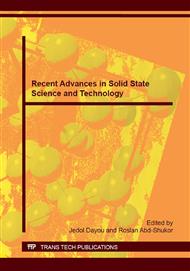p.27
p.33
p.39
p.45
p.59
p.67
p.73
p.79
p.85
Photoconductivity of Pharma-Grade ZnO under UVA and White Light Exposure
Abstract:
In this study, we investigated the photoconductivity of pharma-grade zinc oxide (ZnO) which was excited under ultraviolet - long wavelength (UVA) and white light illumination. The morphological structures of ZnO were studied using field-emission scanning electron microscopy (FESEM) and transmission electron microscopy (TEM). The ZnO sample was composed of micro/nanorods, slabs, tripods, tetrapods and irregular-shaped particles. The energy-dispersive X-ray spectroscopy (EDS) result revealed the high purity of ZnO, with the relative O/Zn atomic ratio lower than 1. The absorption spectrum of ZnO suspension was performed using UV-Visible spectroscopy. ZnO sample exhibited strong absorption at 387 nm, corresponding to optical bandgap of 3.23 eV. The ZnO powder was converted into pellets to study its photoconductivity under different intensity of UVA (0.5-2.0 mW/cm-2) and white light exposure (200-1000 lux) from conventional fluorescent lamp. The significant increase in surface conductivity of the ZnO pellets could be due to UVA illumination that produces photo-generated charge carriers on the surface of ZnO pellet. There was a small persistency of current flow after the UVA exposure was terminated. Under the white light exposure, the surface conductivity was slightly higher than that of dark condition. This is probably due to the small amount of defects, particularly oxygen vacancies and zinc interstitials that produce some light-generated charges on the ZnO crystal structures. The white light exposure may cause the excitation of electrons from the defects energy level to the conduction band, this being the underlying cause for the increase in the conductivity. ZnO pellet exhibited a dramatic enhancement of photoconductivity under UVA illumination if compared with small improvement of photoconductivity under white light exposure.
Info:
Periodical:
Pages:
73-78
Citation:
Online since:
June 2015
Keywords:
Price:
Сopyright:
© 2015 Trans Tech Publications Ltd. All Rights Reserved
Share:
Citation:


